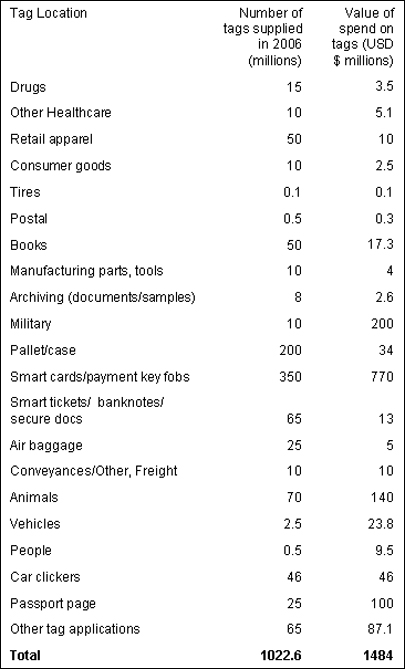Sales of RFID tags throughout the world have gone up, according to Raghu Das, CEO of British research and analysis firm IDTechEx, with 27 percent of all RFID tag sales taking place within the past year. However, Das notes, this is a disappointing number for many who expected faster growth, especially when taking into account that “the biggest spending on tags will be in [contactless] cards in China.”
A total of 1.02 billion passive and active RFID tags was sold worldwide in 2006, the largest percentage of which was for contactless smart cards and payment key fobs, at 350 million, with retail supply chain’s use of pallet and case tags following behind, at 200 million. Among pallets and cases, IDTechEx predicts the demand for tags to rise to 420 million units worldwide for 2007, and to more than 1 billion annually by 2009. The modest sales in pallet and case tags amount to an average of a few hundred thousand tags that each mandated Wal-Mart supplier bought for the whole year.
Nevertheless, Das says, with the prevalence of passive EPC Gen 2 tags—which are much more reliable around liquids and metal—the tags’ higher performance level is likely to lead to a growth in RFID in this sector in 2007. He finds that pallet and case tagging has yet to yield clear benefits and is still mostly being fueled by retail mandates. Retail items such as clothing and books used 50 million passive tags apiece in 2006. Although this represented growth, it was lower than the 70 million passive tags used for identifying animals sold last year, including cattle and sheep, as well as dogs and other pets. The sale of animal tags, IDTechEx predicts, will rise to 90 million in 2007.
“Item-level tagging might be easier than pallet and case,” Das indicates. “When compared to pallets and cases, we see tagging of high-value items as a very fast growth factor.” The retail item-level tagging growth that has taken place is due, in part, to the use of passive RFID tags in closed systems, in which a retailer makes and sells its own products.
One such retailer, he says, is U.K.-based Marks & Spencer (M&S), which has seen a sales increase attributable to its use of item-level tagging to gain visibility of stock availability. Other closed-systems retailers may be expected to invest in RFID systems in 2007. The advantage to closed-system retailers is the ability to develop their own non-standardized systems, as M&S has done.
Das notes that while retail growth has been greatest in closed systems, other large retailers are beginning to find a return on investment when tagging high-value items. According to Das, grocery home-shopping company Tesco and electronics seller Best Buy have begun tagging DVDs and computer video games, respectively, leading to sales growth of these items by 5 to 20 percent.In terms of dollar value, the greatest spending on RFID tags was for RFID-enabled smart cards, used for contactless payments, secure access and mass transit, with $770 million spent last year. The military comes in second, with $200 million spent on 10 million tags, mostly passive EPC tags for tracking cases and pallets of supplies but also active tags for tracking shipping containers. In third place were electronic passports, representing another growth area—up to 25 million passive tags sold at a cost of $100 million.
Tag sales to pharmaceutical companies were modest, according to IDTechEx, in part because the Food and Drug Administration (FDA) has not mandated RFID use in drug packaging. Moreover, the pharmaceutical industry has not yet agreed on a single RFID frequency.
On the other hand, the number of RFID tags sold for tracking airline baggage was up to 25 million last year, a growth that would have been larger had it not suffered from reliability problems with many missed reads in 2006.
In 2007, IDTechEx forecasts that 1.71 billion tags will be sold worldwide, and that the total global RFID spending—including all hardware, systems and integration—will be $4.96 billion. By far, the biggest segment of this is for RFID smart cards in China, though the United States has the majority of RFID sales in all sectors other than contactless cards.
Das forecasts that the global market for RFID hardware, systems and integration will rise to $27.88 billion in 2017. “The main thing to take from this is that RFID is booming in some sectors,” he says, adding that “RFID is incredibly diverse, the market is quite fragmented.”
A more complete picture can be found in a report Das co-wrote with Peter Harrop. The entire report, entitled “RFID Forecasts, Players and Opportunities 2007-2017,” is available at IDTechEx’s Web site.




